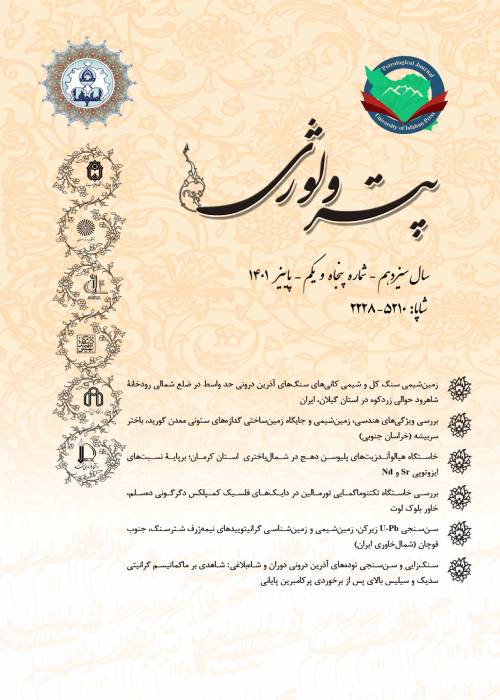Petrography, geochemistry and petrogenesis ofbasaltic rocks in Ali-Abad Garos area as a part of the Sahneh-Harsin ophiolitic complex (east of Kermanshah)
Mesozoic-Paleogene ophiolitic sequences in Iran are in association with opening and closing of Neo-Tethyan oceanic crust. Temporally and specially, these ophiolitic sequences subdivided into five different groups (or belts) (Shafaii Moghadam and Stern, 2014):Zagros outer belt (late Cretaceous-Paleogene); Zagros inner belt (late Cretaceous); Sabzevar- Torbat e Heydarieh belt (late Cretaceous-early Paleocene); Birjand-Nehbandan belt (early to late Cretaceous);
Makran belt (late Jurassic-Cretaceous). The Zagros outer belt’s ophiolitic sequences cropped out along the NW-SE trending Zagros main thrust and including Maku-Khoy-Salmas, Kermanshah (-Kurdistan), Neyriz and Esfandagheh (or Haji-Abad) ophiolites. The Kermanshah ophiolite (KO) is an ophiolitic tectonic complex, which comprises imbricated dismembered fragments of mantle peridotites, gabbros, sheet dykes and basaltic rocks which generally occur as thrust-bound tectonic slices. The Sahneh-Harsin ophiolitic complex(SHOC) is the southeastern part of KO. Detail petrological study has not been carried out on the basaltic rocks from Ali-Abad Garos area(AGA) as a part of the SHOC. Thus, the present study focuses on the field observations, petrographic study as well as whole-rock geochemical analyses (XRF and ICP-MS) of the basaltic rocks widespread in AGA.
Regional geology:
KO cropped out in the northwest of Zagros main thrust (ZMT) where Zagros sedimentary belt join the Sanandaj-Sirjan magmatic-metamorphic belt. In SHOC as the southeastern part of Kermanshah ophiolites Triassic-Cretaceous limestone and radiolarites as well as Mesozoic metamorphic-sedimentary rocks are the oldest lithological units. In the following, ophiolitic sequence related lithological bodies such as peridotites, meta-peridotites, gabbros, meta-gabbros, diabasic dikes and volcanic rocks including pillow lava-massive basalts cropped out which are in accompanied by Eocene extrusive and intrusive rocks. Pliocene to Quaternary sedimentary rocks are the youngest lithological units in Sahneh-Harsin region. In Sahneh-Harsin region ophiolitic sequence related basaltic rocks cropped out in Ali-Abad Garos, Tamark, Gashor areas.
We collected ~70 samples of both pillow lava and massive basaltic rocks in-AGA. Based on petrographic characteristics 10 of the freshest samples were analyzed for whole-rock major and trace elements by X-ray Fluorescence (XRF) and Inductively Coupled Plasma-Mass Spectrometry (ICP-MS) in ALS Chemex lab.
Field observations:
Ali-Abad Garos ophiolitic sequence related basaltic rocks mostly show pillow lava structure. However, minor massive basaltic rocks are exist. In the northern part of the study area basaltic rocks are set atop of gabbroic units. However, gabbro-basalt boundary covered by Quaternary sediments. In some parts, basaltic bodies are in association with plagiogranites. Via a fault boundary upper Triassic-Cretaceous limestone units (Biston Formation) thrusted over basaltic rocks.
Petrography:
The rocks under study are dominated by plagioclase (up to 20%), clinopyroxene (up to 10%) and opaque minerals (up to 2%) phenocrysts set in a fine-grained to glassy ground mass. Chlorite, calcite, epidote, quartz, zeolite and opaque minerals as secondary minerals formed by altered phenocrysts and groundmass. Massive basaltic rocks mostly show porphyritic texture and to lesser extent glomeroporphyritic, intergranular and amygdaloidal textures are present. The rocks studied are characterized by plagioclase (up to 10%), clinopyroxene (up to 20%) and opaque minerals (up to 5%) phenocrysts set in a fine grain to glassy groundmass. Secondary minerals in massive basaltic rocks are similar to those presented for pillow lava basaltic rocks. Whole-rock geochemistry, tectonic setting and source characteristics The studied basaltic rocks show tholeiitic signature. Major element oxides values against SiO2 values, as fractionation index, indicate fractional crystallization as an effective parameter in generation of these rocks. In chondrite-normalized REEs diagram, the basaltic rocks exhibit slight LREE enrichment relative to HREEs (LaN/YbN values ranging from 2.91 to 3.35 and Eu/Eu* values vary from 0.91 to 1.01). In primitive mantle-normalized multi-elements diagram, the patterns of basaltic rocks are consistent with plume related mid-oceanic ridge basalts (P-MORB), against within plate basalt (WPB or OIB), normal mid-oceanic ridge basalts (N-MORB) and enriched mid-oceanic ridge basalts (E-MORB). This case is in agreement with situation of the study samples in basaltic rocks with different geochemical signatures on discriminative diagrams. Parallel trends of the studying basaltic rocks on spider diagrams indicate that they are co-genetic. Also, different elemental ratios as well as the situation of the rocks under study in different geochemical diagrams reveal that parental magma (or magmas) could be formed by low degree partial melting (<3%) of a spinel peridotite as a source rock. Integration of our new presented geochemical data from the study basaltic rocks with other previously presented geochemical data from other ophiolitic sequence related basaltic outcrops within (SHOC) (Tamark and Gashor basaltic rocks) reveal that in this ophiolitic complex basaltic rocks are heterogeneous. Briefly, three different groups of basaltic rocks with P-MORB, E-MORB and OIB geochemical features exist in (SHOC). Comprehensive understanding of relation of these three different basaltic groups are needed to further elemental-isotopic geochemical data coupled with geochronological data.
- حق عضویت دریافتی صرف حمایت از نشریات عضو و نگهداری، تکمیل و توسعه مگیران میشود.
- پرداخت حق اشتراک و دانلود مقالات اجازه بازنشر آن در سایر رسانههای چاپی و دیجیتال را به کاربر نمیدهد.


